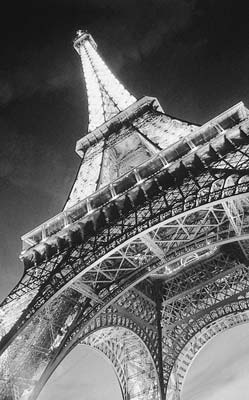
▲▲Champs-Elysées and the Arc de Triomphe
Place de la Concorde, Place Vendôme, and Place de l’Opéra
Place St. Germain-des-Prés and Odéon
Paris is brilliant after dark. Save energy from your day’s sightseeing and experience the City of Light lit. Whether it’s a concert at Sainte-Chapelle, a boat ride on the Seine, a walk in Montmartre, a hike up the Arc de Triomphe, or a late-night café, you’ll see Paris at its best. Night walks in Paris are wonderful. Any of the self-guided walking tours in this book are terrific after dark.
The weekly Pariscope (€0.50, comes out on Wed) or L’Officiel des Spectacles (€0.50) is essential if you want to know what’s going on in Paris. I prefer Pariscope: It offers a complete weekly listing of music, cinema, theater, opera, and other special events. Pick one up at a newsstand and page through it. The order of the contents changes periodically, but the basics described below are always there...somewhere.
The magazine, all in French, begins with a listing of “Théâtre” and what’s playing at all key theater venues. “Musique” lists each day’s events, from jazz to classical to dance (program, location, time, price), including both opera houses if performances are scheduled. Remember that some concerts are free (entrée libre).
A third of the magazine is devoted to cinéma—a Parisian forte. While a code marks films as “Comédie,” “Documentaire,” “Drame,” “Karaté,” “Erotisme,” and so on, the key mark for non-French-speakers is “v.o.,” for version originale (original-language version)—this means the movie hasn’t been dubbed in French. Films are listed alphabetically, by neighborhood (“Salles Paris”) and by genre. To find a showing near your hotel, simply look for a cinema in the same arrondissement. “Salles Périphérie” means the cinema is located out in the suburbs. Many cinemas offer discounts on Monday or Wednesday nights.
“Arts” gives hours and locations for gallery showings (“expositions,” big and small), and up-to-date hours at museums in and near Paris (tlj = daily, sf = except, Ent = entry price, TR = reduced price—usually for students and children).
The “Enfants” section covers a myriad of possible children’s activities from musicals to treasure hunts. “Spectacles” are shows (like magic shows); you’ll also see many “Marionettes” (puppet) shows and “Cirques” (circuses). These events usually are offered only in French, but they can be worthwhile even for non-French-speakers.
“Promenades et Loisirs” covers outdoor events and sights, including open-air theater, flea markets, sound-and-light shows (son et lumières), key monuments such as the Eiffel Tower and Arc de Triomphe, river cruises, parks, zoos, and aquariums.
For cancan mischief, look under “Paris la Nuit.”
Other Resources: Pick up a copy of the free weekly A Nous Paris in the Métro and check out the “Save the Date” section, which is easy to follow even though it’s in French. In these pages, this youth-oriented magazine lists what makes their cut for the most interesting event in Paris each day of the week (printed on Monday, www.anous.fr).
If you prefer your event information in English, the Paris Voice website has helpful reviews of Paris entertainment: www.parisvoice.com. Time Out’s English website is another good resource, with listings for the city’s most talked-about restaurants, reviews of concerts and stores, and ideas for how to enjoy Paris’s nightlife and shopping on a budget (www.timeout.fr/paris/en).
With a lively mix of American, French, and international musicians, Paris has been an internationally acclaimed jazz capital since World War II. You’ll pay €12-25 to enter a jazz club (may include one drink; if not, expect to pay €5-10 per drink; beer is cheapest). See Pariscope magazine under “Musique” for listings, or, even better, the Paris Voice website (www.parisvoice.com). You can also check each club’s website (all have English versions), or drop by the clubs to check out the calendars posted on their front doors. Music starts after 21:00 in most clubs. Some offer dinner concerts from about 20:30 on. Here are several good bets:
Caveau de la Huchette: This fun, characteristic old jazz/dance club fills an ancient Latin Quarter cellar with live jazz and frenzied dancing every night (admission about €13 on weekdays, €15 on weekends, €6-8 drinks, daily 21:30-2:30 in the morning or later, no reservations needed, buy tickets at the door, 5 Rue de la Huchette, Mo: St. Michel, www.caveaudelahuchette.fr).
Autour de Midi et Minuit: This Old World bistro sits at the foot of Montmartre, above a cave à jazz. Eat upstairs if you like (see here for details), then make your way down to the basement to find bubbling jam sessions Tuesday through Thursday and concerts on Friday and Saturday nights (no cover, €5 minimum drink order Tue-Thu; €18 cover Fri-Sat includes one drink; jam sessions at 21:30, concerts usually at 22:00; no music Sun-Mon; 11 Rue Lepic, Mo: Blanche or Abbesses, tel. 01 55 79 16 48, www.autourdemidi.fr).
Other Venues: For a spot teeming with late-night activity and jazz, go to the two-block-long Rue des Lombards, at Boulevard Sébastopol, midway between the river and the Pompidou Center (Mo: Châtelet). Au Duc des Lombards is one of the most popular and respected jazz clubs in Paris, with concerts nightly in a great, plush, 110-seat theater-like setting (admission €20-30, buy online and arrive early for best seats, cheap drinks, shows at 20:00 and 22:00, 42 Rue des Lombards, tel. 01 42 33 22 88, www.ducdeslombards.fr). Le Sunside, run for 19 years by Stephane Portet, is just a block away. The club offers two little stages (ground floor and downstairs): “le Sunset” stage tends toward contemporary world jazz; “le Sunside” stage features more traditional and acoustic jazz (concerts range from free to €25, check their website; generally at 20:00, 21:00, and 22:00; 60 Rue des Lombards, tel. 01 40 26 46 60, www.sunset-sunside.com).
For a less pricey—and less central—concert club, try Utopia. From the outside it’s a hole-in-the-wall, but inside it’s filled with devoted fans of rock and folk blues. Though Utopia is officially a private club (and one that permits smoking), you can pay €3 to join for an evening, then pay a reasonable charge for the concert (usually €10 or under, concerts start about 22:00). It’s located in the Montparnasse area (79 Rue de l’Ouest, Mo: Pernety, tel. 01 43 22 79 66, www.utopia-cafeconcert.fr).
Au Lapin Agile, a historic little cabaret on Montmartre, tries its best to maintain the atmosphere of the heady days when bohemians would gather here to enjoy wine, song, and sexy jokes. Today, you’ll mix in with a few locals and many tourists (the Japanese love the place) for a drink and as many as 10 different performers—mostly singers with a piano. Performers range from sweet and innocent Amélie types to naughty Maurice Chevalier types. And though tourists are welcome, there’s no accommodation for English speakers (except on their website), so non-French-speakers will be lost. You sit at carved wooden tables in a dimly lit room, taste the traditional drink (a small brandy with cherries), and are immersed in an old-time Parisian ambience. The soirée covers traditional French standards, love ballads, sea chanteys, and more (€28, €8 drinks, Tue-Sun 21:00-2:00 in the morning, closed Mon, best to reserve ahead, 22 Rue des Saules, tel. 01 46 06 85 87, www.au-lapin-agile.com; described on here of the  Montmartre Walk chapter).
Montmartre Walk chapter).
For classical music on any night, consult Pariscope magazine (check “Concerts Classiques” under “Musique” for listings), and look for posters at tourist-oriented churches. From March through November, these churches regularly host concerts: St. Sulpice, St. Germain-des-Prés, La Madeleine, St. Eustache, St. Julien-le-Pauvre, and Sainte-Chapelle.
Sainte-Chapelle: Enjoy the pleasure of hearing Mozart, Bach, or Vivaldi, surrounded by 800 years of stained glass (unheated—bring a sweater). The acoustical quality is surprisingly good. There are usually two concerts per evening, at 19:00 and 20:30; specify which one you want when you buy or reserve your ticket. VIP tickets get you a seat in the first nine rows (€40), Prestige tickets cover the next 15 rows (€30), and Normal tickets are the last five rows (€25). Seats are unassigned within each section, so arrive at least 30 minutes early to get through the security line and snare a good view.
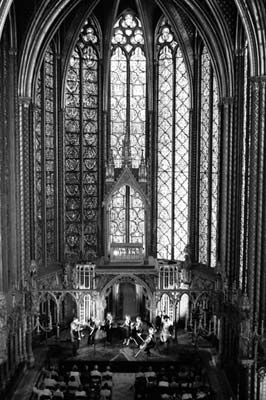
You can book at the box office, by phone, or online. Two different companies present concerts, but the schedule will tell you who to contact for tickets to a particular performance. The small box office (with schedules and tickets) is to the left of the chapel entrance gate (8 Boulevard du Palais, Mo: Cité), or call 01 42 77 65 65 or 06 67 30 65 65 for schedules and reservations. You can leave your message in English—just speak clearly and spell your name. You can check schedules and buy your ticket at www.euromusicproductions.fr.
Flavien from Euromusic offers last-minute discounts with this book when seats are available (limit 2 tickets per book). VIP tickets are discounted to €30, Prestige tickets to €25, and Normal tickets to €16. The offer applies only to Euromusic concerts and must be purchased with cash only at the Sainte-Chapelle ticket booth close to concert time.
Salle Pleyel: This concert hall on the Right Bank hosts world-class artists, from string quartets and visiting orchestras to international opera stars. Tickets range from €10 to €150, depending on the artist and seats you choose, and are usually hard to come by, so it’s best to order online in advance (252 Rue du Faubourg St. Honoré, Mo: Ternes, tel. 01 42 56 13 13, www.sallepleyel.fr).
Concerts on the Seine: Enjoy live classical music while cruising past Paris’ iconic monuments (€30-40, summer months only, board at Vedettes du Pont Neuf, Square du Vert Galant, tel. 01 42 77 65 65, www.vedettesdupontneuf.com/concerts-en-seine-2/).
Other Venues: Look also for daytime concerts in parks, such as the Luxembourg Garden. Even the Galeries Lafayette department store offers concerts. Many of these concerts are free (entrée libre), such as the Sunday atelier concert sponsored by the American Church (generally Sept-June at 17:00 but not every week and not in Dec, 65 Quai d’Orsay, Mo: Invalides, RER: Pont de l’Alma, tel. 01 40 62 05 00, www.acparis.org).
Paris is home to two well-respected opera venues. The Opéra Bastille is the massive modern opera house that dominates Place de la Bastille. Come here for state-of-the-art special effects and modern interpretations of classic ballets and operas. In the spirit of this everyman’s opera, unsold seats are available at a big discount to seniors and students 15 minutes before the show. Standing-room-only tickets for €15 are also sold for some performances (Mo: Bastille). The Opéra Garnier, Paris’ first opera house, hosts opera and ballet performances. Come here for less expensive tickets and grand belle époque decor (Mo: Opéra; generally no performances mid-July-mid-Sept). To get tickets for either opera house, it’s easiest to reserve online at www.operadeparis.fr, or call 01 71 25 24 23 outside France or toll tel. 08 92 89 90 90 inside France (office closed Sun). You can also buy your tickets in person either at Opéra Bastille’s ticket office (Mon-Sat 14:30-18:30 and an hour before the show, closed Sun) or at Opéra Garnier’s ticket office (Mon-Sat 11:30–18:30 and an hour before the show, closed Sun).
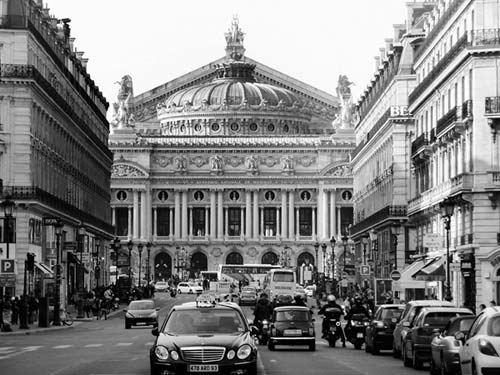
The Open Air Cinema at La Villette (Cinéma en Plein Air) is your chance to relax on the grass and see a movie under the stars with happy Parisians. Films, shown in their original language with French subtitles, start at dusk (free, €7 chair rental, mid-July-Aug Wed-Sun, inside Parc de la Villette complex—enter through main entrance at Cité des Sciences et de l’Industrie, 30 Rue Corentin-Cariou, Mo: Porte de la Villette, www.villette.com).
Various museums are open late on different evenings—called visites nocturnes—offering the opportunity for more relaxed, less crowded visits: the Louvre (Wed and Fri until 21:45), Orsay (Thu until 21:45), Rodin (Wed until 20:45), Pompidou Center (Wed-Mon until 21:00), Grand Palais (Wed until 22:00), Holocaust Memorial (Thu until 22:00), Quai Branly (Thu-Sat until 21:00), and Marmottan Museum (Thu until 20:00). Napoleon’s Tomb and the Army Museum’s WWI and WWII wings are open Tuesdays until 21:00 (April-Sept). See the sidebar on here for a list of attractions that are open late.
Spectacles in the Gardens: An elaborate sound-and-light show (Les Grandes Eaux Nocturnes) takes place at Versailles (€25, mid-June-mid-July Fri-Sat at 21:00, mid-July-mid-Sept Sat only at 21:00, www.chateauversailles.fr).
Several companies offer cruises after dark as well as dinner cruises on huge glass-domed boats (or open-air decks in summer) with departures along the Seine, including from the Eiffel Tower; see “Dinner Cruises” on here of the Eating in Paris chapter. Evening concert cruises are also available in summer months; see “Classical Concerts,” earlier.
Go for an evening walk to best appreciate the City of Light. Break for ice cream, pause at a café, and enjoy the sidewalk entertainers as you join the post-dinner Parisian parade. Use any of this book’s self-guided walking tours as a blueprint, and remember to avoid poorly lit areas and stick to main thoroughfares. Consider the following suggestions; most are partial versions of this book’s longer walking tours.
Adjust your expectations to the changing times. Paris will always be the City of Light, but it shines a little dimmer these days. In an effort to go green and reduce costs, Paris has toned down the lighting on several monuments, including the Arc de Triomphe and the Louvre’s glass pyramid.
This is one of Paris’ most spectacular views at night. Take the Métro to the Trocadéro stop and join the party on Place du Trocadéro for a magnificent view of the glowing Eiffel Tower (see the “Best Views over the City of Light” sidebar on here). It’s a festival of hawkers, gawkers, drummers, and entertainers.
Walk down the stairs, passing the fountains and rollerbladers, then cross the river to the base of the tower, well worth the effort even if you don’t go up (tower open daily mid-June-Aug until 24:45, Sept-mid-June until 23:45).  See the Eiffel Tower Tour chapter.
See the Eiffel Tower Tour chapter.
From the Eiffel Tower you can stroll through the Champ de Mars park past tourists and romantic couples, and take the Métro home (Ecole Militaire stop, across Avenue de la Motte-Picquet from far southeast corner of park). Or there’s a handy RER stop (Champ de Mars-Tour Eiffel) two blocks west of the Eiffel Tower on the river.
The Avenue des Champs-Elysées glows after dark ( see the Champs-Elysées Walk chapter). Start at the Arc de Triomphe (observation deck open daily, April-Sept until 23:00, Oct-March until 22:30), then stroll down Paris’ lively grand promenade. A right turn on Avenue George V leads to the Bateaux-Mouches river cruises. A movie on the Champs-Elysées is a fun experience (weekly listings in Pariscope under “Cinéma”), and a drink or snack at Renault’s futuristic car café is a kick (at #53, toll tel. 08 11 88 28 11).
see the Champs-Elysées Walk chapter). Start at the Arc de Triomphe (observation deck open daily, April-Sept until 23:00, Oct-March until 22:30), then stroll down Paris’ lively grand promenade. A right turn on Avenue George V leads to the Bateaux-Mouches river cruises. A movie on the Champs-Elysées is a fun experience (weekly listings in Pariscope under “Cinéma”), and a drink or snack at Renault’s futuristic car café is a kick (at #53, toll tel. 08 11 88 28 11).
Do a CliffsNotes version of the beautiful  Historic Paris Walk after dinner on the Ile St. Louis (see here).
Historic Paris Walk after dinner on the Ile St. Louis (see here).
Take the Métro (line 7) to the Pont Marie stop, then cross Pont Marie to Ile St. Louis. Turn right up Rue St. Louis-en-l’Ile, stopping for dinner—or at least a Berthillon ice cream (at #31) or Amorino Gelati (at #47). At the end of Ile St. Louis, cross Pont St. Louis to Ile de la Cité, with a great view of Notre-Dame. Wander to the Left Bank on Quai de l’Archevêché, and drop down to the river for the best floodlit views. From May through September you’ll find several moored barges (péniches) that operate as bars. Although I wouldn’t eat dinner on one of these barges, the atmosphere is great for a drink, often including live music on weekends (daily until 2:00 in the morning, closed Oct-April, live music often Thu-Sun from 21:00). End your walk on Place du Parvis Notre-Dame in front of Notre-Dame (tower open Fri-Sat until 23:00 in July-Aug), or go back across the river to the Latin Quarter.
Day or night, this skinny riverfront park dotted with modern art makes for a pleasant walk, but it’s especially fun on balmy evenings in the summer, when you may encounter rock and salsa dancing. It’s on the Left Bank across from Ile St. Louis, running between the Arab World Institute and Jardin des Plantes (free, music around 20:00, very weather-dependent, Quai St. Bernard, Mo: Cardinal Lemoine plus an eight-minute walk up Rue Cardinal Lemoine toward the river).
These three squares tie together nicely for an elegant post-dinner walk (see here in the Shopping in Paris chapter). Take the Métro to Place de la Concorde, and end your three-place stroll with a pricey drink at one of Paris’ grandest cafés (Café de la Paix) across from the old opera. Get out to the obelisk for a terrific view of the Champs-Elysées and the beautifully lit, Greek-looking National Assembly building (to your left as you are looking up the Champs-Elysées). Then walk up Rue Royale toward La Madeleine, turn right on Rue St. Honoré, then left after several blocks on Rue Castiglione. The sumptuous Place Vendôme makes me wish I were rich. Exit Place Vendôme at the opposite end and walk up Rue de la Paix to find Opéra Garnier, stunning at night (see here; Mo: Opéra is right there to take you home).
This artsy neighborhood is a hotbed for nightlife, full of cafés and tiny bars catering to locals and tourists alike. The action centers around Rue Vieille du Temple (Mo: St. Paul), which offers something for every taste and attracts all age groups and sexual persuasions. Look for the Au Petit Fer à Cheval bar and the bookstore/wine bar La Belle Hortense (daily 17:00-24:00, 31 Rue Vieille du Temple, tel. 01 48 04 71 60), and fan out from there. At the western edge of the Marais, you’ll find good boy-meets-girl energy at bars along Rue des Lombards near where it crosses Boulevard de Sebastopol (Mo: Châtelet or Hôtel de Ville, see also “Jazz and Blues Clubs,” earlier).
These areas are close to each other and worth combining for evening fun. The church of St. Germain-des-Prés is often lit up and open at night, and Parisians sip drinks at two famous nearby cafés: Les Deux Magots and Le Café de Flore (see here; Mo: St. Germain-des-Prés). A few blocks toward St. Sulpice Church, night owls prowl along Rues des Canettes and Guisarde, and a few blocks toward the river, they do the same along Rue de Buci (see “Near St. Sulpice Church” on here of the Eating in Paris chapter). The Odéon, a few blocks away, is home to several movie theaters and still more lively cafés.
Several companies offer evening tours of Paris. You can take a traditional, mass-produced bus tour for €27 per person, or for a little more (around €100 per couple), take an hour-long, vintage-car tour with a student guide. A pedicab will take you around for €40-50 per hour. Do-it-yourself-ers can save money by hiring a cab for a private tour (around €45 for one hour). All options are described below.
If rumbling around Paris and sticking your head out of the rolled-back top of a funky old 2CV car à la Inspector Clouseau sounds like your kind of fun, consider this. Two enterprising companies have assembled a veritable fleet of these “tin-can” cars for giving tours of Paris day and night: 4 Roues Sous 1 Parapluie (the better choice) and Paris Authentic. Night is best for the tour; skip it in daylight. The informal student-drivers are not professional guides (you’re paying for their driving services), though they speak some English. Appreciate the simplicity of the car. It’s France’s version of the VW “bug” and hasn’t been made since 1985. Notice the bare-bones dashboard. Ask your guide to honk the horn, to run the silly little wipers, and to open and close the air vent—c’est magnifique!
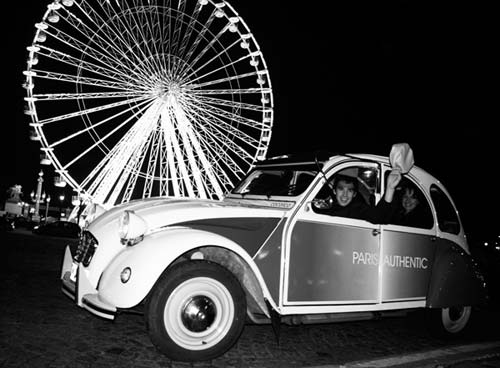
They’ll pick you up and drop you at your hotel or wherever you choose. 4 Roues Sous 1 Parapluie (4 wheels under 1 umbrella), offers several tours with candy-colored cars and drivers dressed in striped shirts and berets. The Essential Ride lasts 1.5 hours and costs €90 per person for two, €60 per person if you fit three passengers, and €180 if you want the whole backseat to yourself, same price and duration for the Illuminated Paris Ride (tel. 08 00 80 06 31, mobile 06 67 32 26 68, www.4roues-sous-1parapluie.com, info@4roues-sous-1parapluie.com). Paris Authentic offers many comparable options with less personal attention (€65/person for 2 people for a 1-hour tour, €50/person for 3 people; €200/couple for a 2-hour tour that includes Montmartre and a bottle of champagne, 10 percent tip appropriate, 23 Rue Jean-Jacques Rousseau, mobile 06 64 50 44 19, www.parisauthentic.com, paris@parisauthentic.com).
Experience the City of Light at an escargot’s pace with your private chauffeur pedaling a sleek, human-powered tricycle from TripUp. Call ahead, book online, or flag one down and use our taxi tour (described later) as a road map; they usually work until about 22:00 (€40-50/hour, mobile 06 98 80 69 33, www.tripup.fr, contact@tripup.fr).
City Vision’s Paris by Night: City Tour connects all the great illuminated sights of Paris with a 100-minute bus tour in 12 languages. The double-decker buses have huge windows, but the most desirable front seats are sometimes reserved for customers who’ve bought tickets for the overrated Moulin Rouge. Left-side seats are better. Visibility is fine in the rain. These tours are not for everyone. You’ll stampede on with a United Nations of tourists, get a set of headphones, dial up your language, and listen to a recorded spiel (which is interesting, but includes an annoyingly bright TV screen and a pitch for the other, more expensive excursions). Uninspired as it is, the ride provides an entertaining overview of the city at its floodlit and scenic best. Bring your city map to stay oriented as you go. You’re always on the bus, but the driver slows for photos at viewpoints (€27, kids-€17, 1.75 hours, departs from 2 Rue des Pyramides at 20:00 Nov-March, at 22:00 April-Oct, reserve one day in advance, arrive 30 minutes early to wait in line for best seats, Mo: Pyramides, tel. 01 42 60 30 01, www.pariscityvision.com). City Vision also offers a Paris by Night tour in a small-group minibus, which follows a similar route to the bus tours. They will pick you up and drop you off at your hotel (€60, kids-€47, 2 hours). For all City Vision tours, buy tickets through your hotel (no booking fee, brochures in lobby) or directly at the City Vision office at 214 Rue de Rivoli, across the street from the Tuileries Métro stop.
You can also take a night tour on L’OpenTour’s double-decker buses (see here) as extensions of their day-tour program (€47 includes day pass and night tour, night tour not sold separately, April-Oct at 22:00, Nov-March at 18:30, depart from 13 Rue Auber, tel. 01 42 66 56 56, www.parisopentour.com).
Seeing the City of Light floodlit is one of Europe’s great travel experiences and a great finale to any day in Paris. Sunday is by far the best night to go, as there’s less traffic—you’ll get a better value for the time spent in a taxi. For less than the cost of two seats on a big bus tour, you can hire your own cab and have a glorious hour of illuminated Paris on your terms and schedule. The downside: You don’t have the high vantage point and big windows of a bus, and taxi drivers can be moody. The upside: It’s cheaper, you go when and where you like, and you can jump out anywhere to get the best views and pictures.
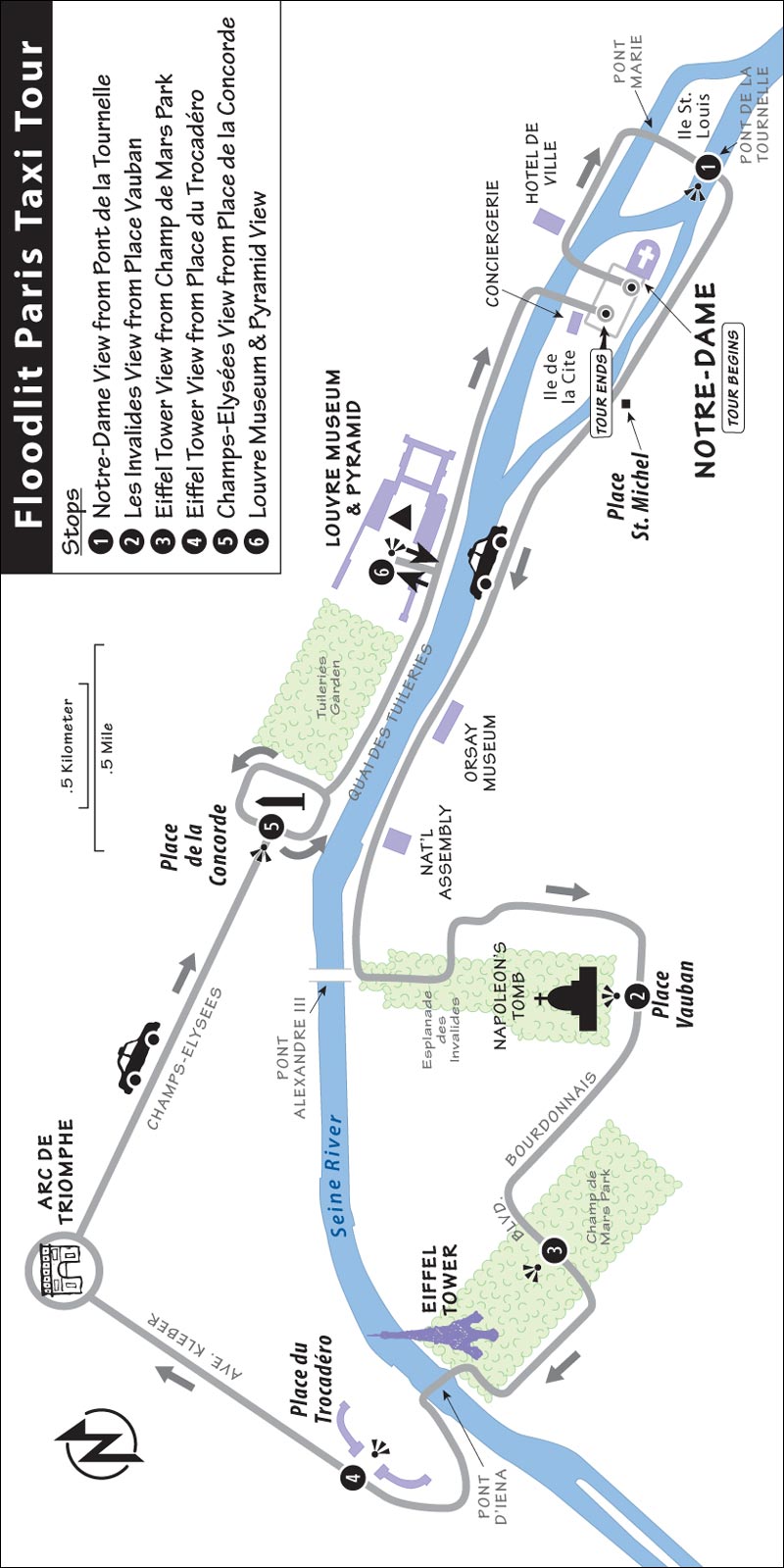
Tour Overview: This is a circular, one-hour route—from Notre-Dame to the Eiffel Tower along the Left Bank, then back along the Right Bank. Start at the taxi stand at Notre-Dame or any convenient point along the route (or from your hotel) and make any stops you like. Suggested stops are listed in bold on the list in “Taxi Instructions” (“petit arrêt” means “little stop”). To make it more of a party, bring a bottle of red wine and some chocolate to enjoy each time you hop out of the taxi (not in the taxi).
Taxi Logistics: Taxis have a strict meter (figure €36/hour plus about €1/kilometer; taxis start with €2.60 on the meter). This suggested loop takes an hour and costs around €45 (more on Sun). If your cabbie was easy to work with, add a 10 percent tip; if not, tip just 5 percent. Traffic can be sparse, and lights are shining between 22:00 and 24:00 every night. Your only timing concern: The Eiffel Tower twinkles for only the first five minutes of each hour after dark. If you start at Notre-Dame at half past the hour, you should be right on time for the sparkles. The driver can take up to four people in a cab, though this is tight for decent sightseeing (with three, everyone gets a window).
Give the driver the instructions printed on the previous page. Before you go, photocopy it (ask at your hotel), or rip the page out (but trace the route on another map so you can follow along). Learn your driver’s name and use it (no first names, use Monsieur or Madame). Make sure the driver understands the plan—and enjoys the challenge. Review with the cabbie exactly where you hope to stop before you start. Let him add a few little deviations (which can be great) as long as he sticks to the general plan. Ask him to drive as slowly as possible (say “Conduisez lentement, s’il vous plaît”—kohn-dwee-zay lahn-tuh-mahn see voo play) so you can enjoy the ever-changing scene.
And you’re on your way. Roll the windows down, and turn the cab light on to read if you like (this is no problem for the driver). Stop when you want (but remember that the meter runs at about €0.50 per minute when stopped). Some cabbies might speak a little English; if not, learn and use the following key words:
| English | French | Pronounced |
| What’s your name? | Comment vous appelez-vous? | koh-mohn vooz ah-play-voo |
| Slower, please | Lentement, s’il vous plaît. | ahn-tuh-mahn see voo play |
| Stop, please. | Arrêtez, s’il vous plaît. | ah-ruh-tay see voo play |
| Wait, please. | Patientez, s’il vous plaît. | pah-see-yahn-tay see voo play |
| I love Paris! | J’adore Paris! | zhah-dor pah-ree |
 Self-Guided Tour: Start at Notre-Dame (taxi stand just in front, on left). Drive over Pont d’Arcole to Hôtel de Ville, then turn right along the Seine (the white stripe of light is a modern bridge connecting the two islands).
Self-Guided Tour: Start at Notre-Dame (taxi stand just in front, on left). Drive over Pont d’Arcole to Hôtel de Ville, then turn right along the Seine (the white stripe of light is a modern bridge connecting the two islands).
Cross the Ile St. Louis on Pont Marie. Stop on the next bridge (Pont de la Tournelle) just after the island, get out, and giggle with delight at the city and illuminated Notre-Dame. Then turn right along the Seine on Quai de la Tournelle, motoring scenically past Notre-Dame.
Drive west along the entire length of the long Louvre—once the world’s biggest building (across the river), then under the Orsay Museum (above you, on left). The National Assembly (on left) faces Place de la Concorde (on right). The ornate Pont Alexandre III comes next (on right).
Turn left down Esplanade des Invalides to the gilded dome of Les Invalides, marking Napoleon’s Tomb. As you approach the grand building, watch the illusion of the fancy dome sinking behind the facade. Circle clockwise around Invalides for a close-up view. Get out at Place Vauban (behind the dome) and marvel at its symmetry.
Take Avenue de Tourville to Avenue de la Bourdonnais, which runs alongside the Champ de Mars park (former military training grounds that now serve as the Eiffel Tower’s backyard). Turn left onto Avenue Joseph Bouvard, leading to a circle made to order for viewing the Eiffel Tower. Get out and gasp.
Pont d’Iéna leads from directly in front of the tower across the Seine to Place du Trocadéro for another grand Eiffel view (get out again and walk toward the tower to get the best photos and to enjoy the night scene here).
Avenue Kléber leads through one of Paris’ ritziest neighborhoods to the Arc de Triomphe. Battle twice around the eternal flame marking the Tomb of the Unknown Soldier and Paris’ craziest traffic circle: Ask for “Deux révolutions, s’il vous plaît” (duh ray-voh-loo-see-yohn see voo play). Notice the rules of the road: Get to the center ASAP, those entering have the right-of-way, and any accidents are no-fault (insurance companies split the costs down the middle). As you circle, notice the uniform boulevards reaching out like spokes from this hub. Try to find the huge and modern La Grande Arche in the distance opposite the Champs-Elysées.
When ready to continue, say the rhyme, “Champs-Elysées, s’il vous plaît” (shahnz ay-lee-zay see voo play). Glide down Europe’s grandest boulevard—past fancy restaurants, car dealerships, and theaters—to the bold white obelisk marking the former site of the guillotine, Place de la Concorde.
Circle once (maybe twice) around Place de la Concorde, picking out all the famous landmarks near and far. Stop at the center to look up the Champs-Elysées. Then continue east (reminding your cabbie the next stop is “la Pyramide du Louvre”) along the Seine on Quai des Tuileries (the two train-station clocks across the river mark the Orsay Museum) and sneak (via a taxi/bus-only lane) into the courtyard of the Louvre for a close look at the magically glowing pyramid. Stop here.
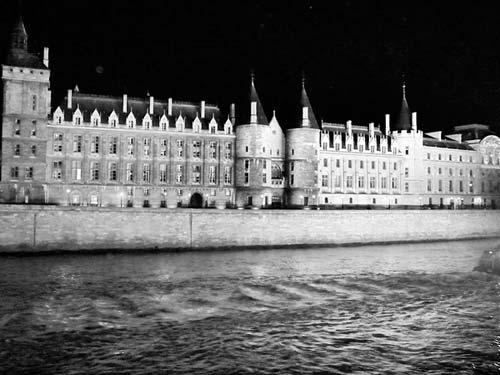
Return to the riverfront along the Right Bank and pass the oldest bridge in Paris, Pont Neuf, and the impressive Conciergerie with its floodlit medieval turrets (this is where Marie-Antoinette was imprisoned during the Revolution). Turn right on Pont de Notre-Dame and you complete the loop back where you (and Paris) started, at Place du Parvis, facing Notre-Dame on the Ile de la Cité. Or you can ask your cabbie to take you back to your hotel (roughly €15 more).
End your night tour by giving your cabbie a hearty thank you: “Merci, monsieur! Bonne soirée!”